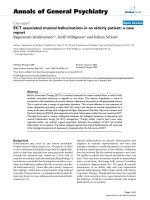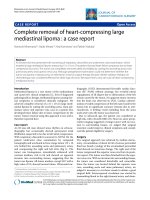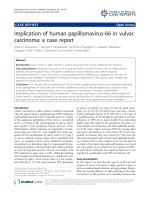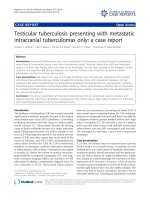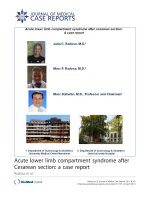Báo cáo y học: " Ascending cholangitis presenting with Lactococcus lactis cremoris bacteraemia: a case report" pot
Bạn đang xem bản rút gọn của tài liệu. Xem và tải ngay bản đầy đủ của tài liệu tại đây (178.43 KB, 4 trang )
BioMed Central
Page 1 of 4
(page number not for citation purposes)
Journal of Medical Case Reports
Open Access
Case report
Ascending cholangitis presenting with Lactococcus lactis cremoris
bacteraemia: a case report
Jane Davies*
†1
, Michael David Burkitt
†2
and Alastair Watson
2
Address:
1
Tropical and Infectious Diseases Unit, Royal Liverpool and Broadgreen University Hospitals Trust, Prescot Street, Liverpool, L7 8XP, UK
and
2
The Henry Wellcome Laboratories, Unit of Gastroenterology, School of Clinical Science, 1st Floor Nuffield Building, Ashton Street, The
University of Liverpool, Liverpool, L69 3GE, UK
Email: Jane Davies* - ; Michael David Burkitt - ;
Alastair Watson -
* Corresponding author †Equal contributors
Abstract
Introduction: A case of Lactococcus lactis cremoris causing cholangitis is described. This Gram-
positive organism is not routinely considered to be pathogenic in immunocompetent individuals.
To our knowledge, this is the thirteenth report of invasive infection and the first of cholangitis to
be reported in association with this organism.
Case presentation: A 72-year-old patient presented with Charcot's triad and was demonstrated
to have cholangitis with Lactococcus lactis cremoris bacteraemia. Biliary drainage was achieved
through endoscopic retrograde cholangiography. Antibiotic therapy with multiple agents was
necessary.
Conclusion: This report provides corroboration of evidence that Lactococcus lactis cremoris is a
potential pathogen in immunocompetent adults. There remains a debate about the most
appropriate empirical antibiotic therapy in this condition. In the light of this case, it is important to
keep an open mind to potential pathogens.
Introduction
Lactococcus lactis cremoris is commonly considered to be a
non-pathogenic organism in humans. It is recognized as a
commensal organism of mucocutaneous surfaces, how-
ever, over the past 50 years, there have been a number of
case reports [1-11] demonstrating the potential for this
organism to cause infection. We report the first case of
cholangitis associated with septicaemia caused by Lacto-
coccus lactis cremoris.
Case presentation
A 72-year-old lady, normally fit and well, presented with
a 5-day history of jaundice and abdominal pain. She was
nauseated and had dark urine. On initial assessment, she
was deeply icteric and her temperature was 38.2°C but
she was haemodynamically stable. Systemic examination
did not reveal any other abnormalities, specifically there
were no stigmata of chronic liver disease. No organs or
lymph nodes were palpable and the abdomen was soft
and non-tender.
Biochemical analyses demonstrated a leukocytosis and
neutrophilia; haemoglobin (Hb) 11.9 g/dL, white blood
cell count (WCC) 13.9 × 10
9
/L, neutrophils 11.4 × 10
9
/L.
An acute phase response was evident with C-reactive pro-
tein (CRP) 131 mg/L. A mixed cholestatic and hepatic pic-
Published: 6 January 2009
Journal of Medical Case Reports 2009, 3:3 doi:10.1186/1752-1947-3-3
Received: 18 February 2008
Accepted: 6 January 2009
This article is available from: />© 2009 Davies et al; licensee BioMed Central Ltd.
This is an Open Access article distributed under the terms of the Creative Commons Attribution License ( />),
which permits unrestricted use, distribution, and reproduction in any medium, provided the original work is properly cited.
Journal of Medical Case Reports 2009, 3:3 />Page 2 of 4
(page number not for citation purposes)
ture of hepatic enzymes with alkaline phosphatase (ALP)
340 U/L, alanine aminotransferase (ALT) 240 U/L and
gamma-glutamyl-transferase (γGT) 381 U/L was demon-
strated; total bilirubin was 351 μmol/L. Hepatic synthetic
function was preserved with albumin 30 g/L and pro-
thrombin time (PT) of 13.8 seconds. A clinical diagnosis
of cholangitis was made on the basis of Charcot's triad
(abdominal pain, fever and jaundice), and empirical anti-
biotic therapy (oral ciprofloxacin 500 mg bd) was com-
menced.
An ultrasound of the biliary tree was performed demon-
strating dilatation of the common bile duct to 1.5 cm with
visualization of at least one stone in the lumen of the duct.
Intrahepatic duct dilatation was also noted. Blood cul-
tures confirmed a Lactococcus lactis cremoris septicaemia.
The organism was sensitive to tazobactam/piperacillin
and co-amoxiclav. In light of these results, antibiotic ther-
apy was changed to intravenous tazobactam/piperacillin
4.5 g tds.
The patient proceeded to endoscopic retrograde cholangi-
opancreatogram (ERCP) where an impacted common bile
duct stone was identified. Unfortunately, this was not
amenable to endoscopic removal despite sphincterotomy;
however two biliary stents were inserted with good drain-
age.
The patient recovered rapidly with resolution of her symp-
toms and signs and was discharged home 48 hours post-
ERCP. Treatment was completed with 2 weeks of oral co-
amoxiclav 625 mg tds.
Discussion
The Tokyo Consensus guidelines of 2007 have now estab-
lished definitive diagnostic criteria and severity assess-
ment of cholangitis [12]. The diagnosis of cholangitis is
made either by the presence of Charcot's triad or by the
presence of two of these features backed up by abnormal
liver function tests, raised inflammatory markers and
imaging demonstrating a dilated biliary tree. Severity is
assessed by the presence or absence of organ failure once
a diagnosis has been made and response to initial therapy.
As our patient had no signs of organ failure but failed to
respond to the primary treatment, she constitutes cholan-
gitis of moderate severity.
Empirical antibiotic therapy for cholangitis is targeted
towards gut organisms, particularly Gram-negative organ-
isms. Commonly (including in our unit), ciprofloxacin is
considered to be an appropriate empirical therapy. This is
backed up by reports of an 85% clinical cure rate in trials
[13]. The Tokyo Consensus group [13] failed to recom-
mend a single specific empirical treatment, therefore local
antibiotic guidelines will continue to direct empirical
therapy. In the presence of positive microbiological inves-
tigations, there is a clear consensus that agents should be
changed for more appropriate treatment according to sen-
sitivity.
Biliary drainage reduces mortality and speeds recovery
from cholangitis and is therefore a vital part of manage-
ment [14]. The Tokyo guidelines recognize that this must
be done in an emergency setting for patients with severe
cholangitis and as promptly as practical in other patients.
Endoscopic drainage is the preferred modality [15].
Lactococcus lactis cremoris is a Gram-positive coccus, for-
merly classified as Streptococcus cremoris but now recog-
nized as a member of the genus Lactococcus [3]. This
species is commonly regarded as non-pathogenic in
immunocompetent adults, however we report the thir-
teenth case to our knowledge of this pathogen causing
clinically significant infection. Previously, four cases of
bacterial endocarditis [4,6,9,11], one of septicaemia [7],
two liver abscesses [3,5] and one each of necrotizing
pneumonitis [10], septic arthritis [8], deep neck infection
[2], cerebellar abscess [4] and canaliculitis [1] have been
reported. Of these, it appears that nine were immunocom-
petent patients. All bar one of the case reports were in
adults (Table 1).
Lactococcus lactis cremoris is a recognized skin commensal
of cattle and is also used in the dairy industry for milk fer-
mentation. It may therefore be present in unpasteurized
dairy products. Of the previously reported cases, six have
been associated with a clear history of exposure to unpas-
teurized dairy products; in one of these cases, the organ-
ism was isolated from the milk product (Table 1). Our
patient is not aware of having had any such exposure.
Conclusion
This report provides corroboration of evidence that Lacto-
coccus lactis cremoris is a potential pathogen in immuno-
competent adults. Lactococcus lactis cremoris has now been
reported as a pathogen in many different systems, both
acutely and subacutely. This may well represent an under-
reporting of the true incidence of invasive infection
related to this organism.
Diagnosis and assessment of the clinical severity of
cholangitis are now the subject of consensus guidelines.
These guidelines also extend to the appropriate timing
and method of biliary drainage. However, there remains a
debate about the most appropriate empirical antibiotic
therapy in this condition. In the light of this case, it is
important to consider other potential pathogens causing
ascending cholangitis.
Journal of Medical Case Reports 2009, 3:3 />Page 3 of 4
(page number not for citation purposes)
Abbreviations
Hb: haemoglobin; WCC: white cell count; CRP: C-reactive
protein; ALT: alanine aminotransferase; ALP: alkaline
phosphatase; γGT: gamma-glutamyl-transferase; PT: pro-
thrombin time; bd: twice daily; tds: three times daily;
ERCP: endoscopic retrograde cholangiopancreatogram
Consent
Written informed consent was obtained from the patient
for publication of this case report and any accompanying
images. A copy of the written consent is available for
review by the Editor-in-Chief of this journal.
Competing interests
The authors declare that they have no competing interests.
Authors' contributions
JD and MDB were involved in patient care, carried out the
review of literature and were jointly responsible for draft-
ing and revising the manuscript. AJMW has provided edi-
torial and clinical supervision.
References
1. Leung DYL, Kwong YYY, Ma CH, Wong WM, Lam DSC: Canalicu-
litis associated with a combined infection of lactococcus lactis
cremoris and eikenella corrodens. Jpn J Ophthalmol 2006,
50:284-298.
2. Koyuncu M, Acuner IC, Uyar M: Deep neck infection due to lac-
tococcus lactis cremoris: A case report. Eur Arch Otorhinolaryngol
2005, 262(9):719-721.
3. Antolin J, Ciguenza R, Saluena E, Vazquez J, Hernandez J, Espinos D:
Liver abscess caused by lactococcus lactis cremoris: A new
pathogen. Scand J Infect Dis 2004, 36:490-491.
4. Akhaddar A, El Mostarchid B, Gazzaz M, Boucetta M: Cerebellar
abscess due to lactococcus lactis. A new pathogen. Acta Neu-
rochir (Wien) 2002, 144:305-306.
Table 1: Previously reported cases of Lactococcus lactis cremoris associated infections
Year Age Sex Site of infection Exposure to
unpasteurized milk
products
Treatment Outcome Immune status
2006 [1] 80 F Canaliculitis None Oral ampicillin and
topical chloramphenicol
Complete resolution Normal
2005 [2] 68 M Deep neck infection Cow breeder and
consumed
unpasteurized milk
Ceftriaxone and
metronidazole for 6
weeks
Resolution on discharge Previous
malignancy
2004 [3] 79 F Liver abscess None Percutaneous drainage,
Imipenem Cilastatin for
5 weeks
Complete resolution Normal
2002 [4] 45 F Cerebellar abscess Not commented Ceftriaxone 8 weeks,
gentamicin 2 weeks,
Metronidazole
No residual deficit and no
recurrence at 9 months
Normal
2002 [3] 67 M Endocarditis History of drinking
unpasteurized milk
Co-amoxiclav and
gentamicin 15 days
Well 6 months post
discharge
Normal
Penicillin for 6 weeks
2000 [5] 14 F Liver abscess None Percutaneous drainage Discharged from hospital
on day 48
Normal
Cefotiam, Amikacin and
Clindamycin for 8 days
Panipenem for 8 days
Piperacillin 15 days and
amikacin 10 days
1996 [6] 56 M Endocarditis None Penicillin G for 12 days
and Clarithromycin for
18 days
Well 18 months post
discharge
Normal
1995 [7] 69 M Septicaemia Yoghurt ingested Cefotaxime and
Amikacin
No comment Chronic
lymphocytic
leukaemia
1993 [8] 57 F Septic arthritis Unpasteurized milk Penicillin for 6 weeks Deformity 8 months post
discharge, but no ongoing
infection
Normal
1990 [9] 65 F Endocarditis Not commented Benzylpenicillin and
gentamicin
No ongoing infection Normal
1990 [10] 24 M Necrotizing
pneumonitis and
empyema
Unpasteurized milk
and cheese eaten
Thoracocentesis (*3)
Penicillin and
clindamycin 15 days
Well 1 month post
discharge
HIV positive
1955 [11] 21 M Endocarditis Sour cream known to
contain S. Lactis
Penicillin and
Dihydrostreptomycin
for 22 days
Well 4 months post
discharge
Normal
Publish with BioMed Central and every
scientist can read your work free of charge
"BioMed Central will be the most significant development for
disseminating the results of biomedical research in our lifetime."
Sir Paul Nurse, Cancer Research UK
Your research papers will be:
available free of charge to the entire biomedical community
peer reviewed and published immediately upon acceptance
cited in PubMed and archived on PubMed Central
yours — you keep the copyright
Submit your manuscript here:
/>BioMedcentral
Journal of Medical Case Reports 2009, 3:3 />Page 4 of 4
(page number not for citation purposes)
5. Nakarai T, Morita K, Nojiri Y, Nei J, Kawamori Y: Liver abscess due
to lactococcus lactis cremoris. Paediatr Int 2000, 42:699-701.
6. Pellizzer G, Benedetti P, Biavasco F, Manfrin V, Franzetti M, Scagnelli
M, Scarparo C, de Lalla F: Bacterial endocarditis due to lactococ-
cus lactis subsp. cremoris: case report. Clin Microbiol Infect 1996,
2:230-232.
7. Durand JM, Rousseau MC, Gandois JM, Kaplanski G, Mallet MN,
Soubeyrand J: Streptococcus lactis septacemia in a patient
with chronic lymphocytic leukemia. Am J Hematol 1995,
50:64-65.
8. Campbell P, Dealler S, Lawton JO: Septic arthritis and unpasteur-
ised milk. J Clin Pathol 1993, 46:1057-1058.
9. Mannion PT, Rothburn MM: Diagnosis of bacterial endocarditis
caused by Streptococcus lactis and assisted by immunoblot-
ting of serum antibodies. J Infect 1990, 21:317-326.
10. Torre D, Sampietro C, Fiori GP, Luzzaro F: Necrotizing pneumo-
nitis and emphysema caused by streptococcus cremoris
from milk. Scand J Infect Dis 1990, 22:221-222.
11. Wood HF, Jacobs K, McCarty M: Streptococcus lactis isolated
from a patient with subacute bacterial endocarditis. Am J Med
1955, Feb:345-347.
12. Wada K, Takada T, Kawarada Y, Nimura Y, Miura F, Yoshida M,
Mayumi T, Strasberg S, Pitt HA, Gadacz TR, Büchler MW, Belghiti J,
de Santibanes E, Gouma DJ, Neuhaus H, Dervenis C, Fan ST, Chen
MF, Ker CG, Bornman PC, Hilvano SC, Kim SW, Liau KH, Kim MH:
Diagnostic criteria and severity assessment of acute cholan-
gitis: Tokyo Guidelines. J Hepatobiliary Pancreat Surg 2007,
14:52-58.
13. Tanaka A, Takada T, Kawarada Y, Nimura Y, Yoshida M, Miura F,
Hirota M, Wada K, Mayumi T, Gomi H, Solomkin JS, Strasberg SM,
Pitt HA, Belghiti J, de Santibanes E, Padbury R, Chen MF, Belli G, Ker
CG, Hilvano SC, Fan ST, Liau KH: Antimicrobial therapy for
acute cholangitis: Tokyo Guidelines. J Hepatobiliary Pancreat Surg
2007, 14:59-67.
14. Lygidakis NJ: Acute suppurative cholangitis: Comparison of
internal and external biliary drainage. Am J Surg
1982,
143:304-306.
15. Nagino M, Takada T, Kawarada Y, Nimura Y, Yamashita Y, Tsuyuguchi
T, Wada K, Mayumi T, Yoshida M, Miura F, Strasberg SM, Pitt HA,
Belghiti J, Fan ST, Liau KH, Belli G, Chen XP, Lai EC, Philippi BP, Singh
H, Supe A: Methods and timing of biliary drainage for acute
cholangitis: Tokyo Guidelines. J Hepatobiliary Pancreat Surg 2007,
14:68-77.
